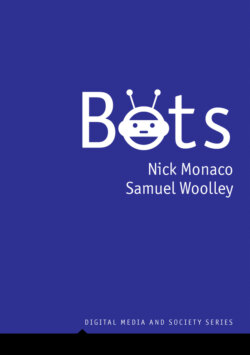Читать книгу Bots - Nick Monaco - Страница 13
Bots and online gaming on MUD environments
ОглавлениеIn addition to Usenet and IRC, computer games were also a hotbed of early bot development. From 1979 on, chatbots were relatively popular in online gaming environments known as MUDs (“multi-user domains” or “multi-user dungeons”). MUDs gained their name from the fact that multiple users could log into a website at the same time and play the same game. Unlike console games, MUDs were text-based and entirely without graphics,5 due to early computers’ limited memory and processing power, making them an ideal environment for typed bot interaction. These games often had automated non-player characters (NPCs) that helped move gameplay along, providing players with necessary information and services. MUDs remained popular into the 1990s, and users increasingly programmed and forked their own bots as the genre matured (Abokhodair et al., 2015; Leonard, 1997).
ELIZA, the original chatbot from the 1960s, served as a prototype and inspiration for most MUD chatbots. One of the big 1990s breakthroughs for MUD bots was a chatbot named Julia. Julia was part of an entire family of bots called the Maas-Neotek Family, written by Carnegie Mellon University graduate student Michael “Fuzzy” Mauldin for TinyMUD environments. Julia, a chatbot based on ELIZA’s code, inspired MUD-enthusiasts to build on the publicly available code from Maas-Neotek bots, to hack together their own bot variants (Foner, 1993; Julia’s Home Page, 1994; Leonard, 1997, pp. 40–42). Bots became legion in TinyMUDs – at one point, a popular TinyMUD that simulated a virtual city, PointMOOt, had a population that was over 50 percent bots (Leonard, 1996) – which was an essential part of the appeal for both players and developers.
